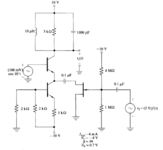IronKeeper
Newbie
Hi! I'm solving a college exercise list of a Electronics subject and one of the questions is the exercise 8.10 from the book "Communication Circuits Analysis and Design".
The statement is the following:
For the circuit below, calculate v0(t) assuming that f(t) is a square wave with transitions between +1 and -1
Can someone please help? I've attached the circuit design.
Thanks!
The statement is the following:
For the circuit below, calculate v0(t) assuming that f(t) is a square wave with transitions between +1 and -1
Can someone please help? I've attached the circuit design.
Thanks!
